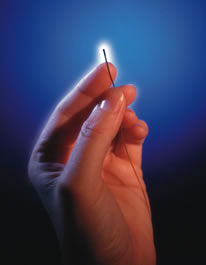
MOSFET Dose Verification Systems
Please click the product you want to learn more about:
MOSFET Products & Accessories
MOSFET Products & Accessories
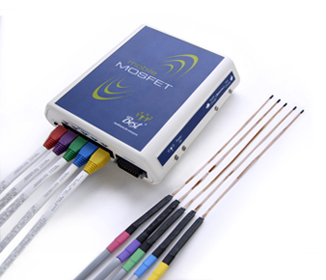
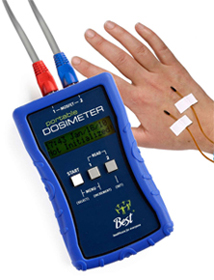
Best Medical Canada has been the pioneer of in-vivo dosimetry for radiotherapy, brachytherapy and radiology applications for over 30 years. BMC MOSFETs (TN-502RD-H) are real-time dose readout dosimeters that connect to a wireless and battery-operated mobileMOSFET reader. The advanced features of the software allow for dose verification in comparison to target dose, and electronic dose reporting with data transfer to R∧V systems. The hand-held Portable Dosimeter system is intended for cost-effective MOSFET dosimetry and portability during clinical use at uncompromised accuracy. BMC MOSFETs, based on patented dual MOSFET technology, are the only in-vivo dosimeters with unmatched dosimetric characteristics such as temperature independence, gantry angle, dose rate, energy and good linearity at full dose range.
In addition, we have developed various product accessories providing tools to enhance the quality of treatment delivered by medical professionals. For example, we provide build-up caps for Dmax measurements and different types of dosimeters tailored towards various applications in radiotherapy. We have also developed a calibration jig specifically for MOSFET dosimeters which promotes reproducible calibration.
Other Products Distributed by Best Medical Canada
MOSFET Dosimetry
MobileMOSFET
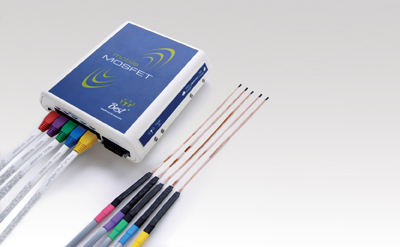
Wireless Dose Verification System
The mobileMOSFET dose verification system (TN-RD-70-W) takes MOSFET dosimetry to the next level.
The mobileMOSFET is a portable, easy-to-use, seamlessly integrated system that simplifies dosimetry and minimizes QA time, making it ideal for a busy radiotherapy center. For example, one Reader Module can be easily shared between multiple treatment rooms (with LAN connections and additional transceivers).
This new wireless system is entirely software driven, allowing for remote control of one or more systems from a PC. The system consists of Remote Monitoring Dose Verification Software, wall-mounted Bluetooth™ Wireless Transceiver and a small Reader Module that acts as a channel between the MOSFET and software, providing a final dose report for patient records. Up to five MOSFETs or one Linear 5ive Array can be plugged into one module. This provides easy mobility within the treatment room. The PC is online with the Reader Module and the dose is obtained in real time.
Portable Dosimeter

The Portable Dosimeter, model TN-RD-90, is an economical, compact, stand-alone system for radiation dose measurement.
Patient dosimetry measurements are available at the touch of a button and display on the integrated LCD, without the need for software or a computer. Additionally, the rechargeable battery powered dosimeter allows easy transportation from room-to-room, or hospital-to-hospital.
The Portable Dosimeter supports up to two simultaneous dose points with any of the Best Medical Canada single MOSFETs on standard or high bias setting for optimal dose reproducibility. An automatic mode is available to continuously sample dose data at a fixed time interval during a session.
After every measurement the dosimetry data is automatically stored to memory for later viewing and can be downloaded to a computer via a USB connection and the PortableDose Connect software. A simple, menu driven interface allows customization of calibration factors, dose units and operational settings directly on the Portable Dosimeter. To save you time, a library of default calibration factors is stored in the memory, but the user also has the choice of entering their customized calibration factors.
Radiotherapy clinics can utilize the Portable Dosimeter for patient dose QA, or to measure exposures to regions-at-risk. In diagnostic radiology, the system is ideal for residual exposure dose measurements, and protocol evaluation.
For one-to-two dose points, the Portable dosimeter is a fast, simple solution for patient dosimetry that can be used for a wide range of applications in radiotherapy and radiology.
- Stand-alone reader with LCD
- Portable and compact
- Quick set-up time
- Simple menu operation
- Supports two MOSFET dosimeters
- Supports all single Best Medical Canada MOSFETs
- Optional data export via USB and PortableDose Connect software
- Calibration factor library
- Long rechargeable battery life
- Manual measurement mode, or Automatic Sequential mode
- No software or computer necessary
- In vivo dose – photon or electron
- Skin entrance and exit dose (TBI)
- Dmax dose measurements
- IMRT and Tomotherapy
- Brachytherapy
- Pediatric CT dose
- Fluoroscopy dose
Linear 5ive MOSFET Array
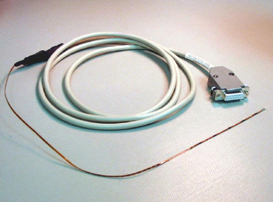
Dosimeter
The Linear 5ive MOSFET Array for Radiotherapy applications is ideal for LDR/HDR Brachytherapy and IMRT QA. It is compatible with the mobileMOSFET. The Array contains five isotropic, energy independent MOSFET dosimeters at 2cm intervals. The MOSFETs on the array can be read simultaneously, facilitating multiple dose measurements at several spatial points. The radio-opaque marker, located at the tip of the array, enables visualization under X-ray imaging including CT and Fluoroscopy, allowing for 5 dosimetry points to be accurately located and easily compared to the target doses.
The isotropic Linear 5ive Array, with excellent reproducibility and linearity, is the tool of choice for a variety of radiotherapy applications such as in-vivo dosimetry and Beam Quality Assurance.
The array can be used effectively for direct measurement of intracavitary dose profiles. During gynecological and prostate procedures, five dose points can be read directly from a computer, displaying the dose profile of the organ at risk in real-time. This is then compared to the planned target dose, allowing for immediate assessments of post-implant base and apex dose, as well as the dose to the organs at risk (eg. urethra, rectum or bladder).
Two arrays crossing at the isocenter of a beam will provide quick 2D dose profiling with 10 simultaneous dose point readings for the X and Y-axes. Since arrays are isotropic, multiple beams at different gantry angles (as in IMRT) can be accurately and quickly compared.
MOSFET Dosimeters
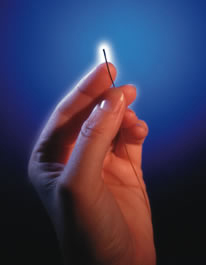
Best Medical Canada, through CNMC Company, offers three different styles of MOSFET dosimeters. With each of these dosimeters are also options that can be selected. All our dosimeters have the same unique features:
- One calibration factor for all photon and electron modalities in the radiotherapy energy range
- Isotropic (±3% or better for 360®)
- Active region of 0.2 x 0.2mm
- Permits pinpoint measurement without patient shielding
- Dose-rate and temperature independent
- Unobtrusive in procedures
- Lightweight and flexible
- Multiple dosimeter capability with one reader
MOSFET In-Vivo Dosimetry
MobileMOSFET

Wireless Dose Verification System
Part # TN-RD-70W
The mobileMOSFET Dose Verification System (Part # TN-RD-70W) takes MOSFET dosimetry to the next level.
The mobileMOSFET is a portable, easy-to-use, seamlessly integrated system that simplifies dosimetry and minimizes QA time, making it ideal for a busy radiotherapy center. For example, one Reader Module can be easily shared between multiple treatment rooms (with LAN connections and additional transceivers).
This new wireless system is entirely software driven, allowing for remote control of one or more systems from a PC. The system consists of Remote Monitoring Dose Verification Software, wall-mounted Bluetooth™ Wireless Transceiver, and a small Reader Module that acts as a channel between the MOSFET and software, and provides a final dose report for patient records. Up to five MOSFETs or one Linear 5ive Array can be plugged into one module. This provides easy mobility within the treatment room. The PC is on-line with the Reader Module and dose is obtained in real-time.
Portable Dosimeter

Part # TN-RD-90
The Portable Dosimeter (model TN-RD-90) is an economical, compact, stand-alone system for radiation dose measurement.
Patient dosimetry measurements are available at the touch of a button and display on the integrated LCD, without the need for software or a computer. Additionally, the rechargeable battery powered dosimeter allows easy transportation from room-to-room, or hospital-to-hospital.
The Portable Dosimeter supports up to two simultaneous dose points with any of Arplay Medical’s single MOSFETs on standard or high bias setting for optimal dose reproducibility. An automatic mode is available to continuously sample dose data at a fixed time interval during a session.
After every measurement the dosimetry data is automatically stored to memory for later viewing and can be downloaded to a computer via a USB connection and the PortableDose Connect software. A simple, menu driven interface allows customization of calibration factors, dose units and operational settings directly on the Portable Dosimeter. To save you time, a library of default calibration factors is stored in the memory, but the user also has the choice of entering their customized calibration factors.
Radiotherapy clinics can utilize the Portable Dosimeter for patient dose QA, or to measure exposures to regions-at-risk. In diagnostic radiology, the system is ideal for residual exposure dose measurements, and protocol evaluation.
For one-to-two dose points, the Portable dosimeter is a fast, simple solution for patient dosimetry that can be used for a wide range of applications in radiotherapy and radiology.
MOSFET Dosimeters
Arplay Medical offers three different styles of MOSFET dosimeters from Best Medical Canada, as shown in the table below. With each of these dosimeters there are also options that can be selected. All of our dosimeters have the same unique features:
- One calibration factor for all photon & electron modalities in the radiotherapy energy range.
- Isotropic (± 3% or better for 360°.)
- Active region of 0.2 x 0.2 mm
- Permits pinpoint measurement without patient shielding.
- Dose-rate and temperature independent.
- Unobtrusive in procedures.
- Lightweight and flexible.
- Multiple dosimeter capability with one reader.
| Dosimeter | Width of Flex | Length of Flex | Thickness of Flex | Common Use |
|---|---|---|---|---|
| Standard MOSFET | 2.5 mm | 200 mm | 0.3 mm | Dose verification during radiotherapy treatments; beam QA |
| Thin MOSFET | 2.5mm | 200mm | 0.3mm | Flexible cable allows for easy handling, particularly during treatments involving pediatric or elderly patients. |
| microMOSFET | 1.0 mm | 375 mm | 0.3 mm | Fits down a 6Fr catheter for dose verification during HDR brachytherapy procedures |
| Linear 5ive Array | 1.5 mm | 460 mm | 1.3 mm | Measurement of urethral dose during prostate brachytherapy procedures |
| Options | Use |
|---|---|
| High Sensitivity | These dosimeters are made more sensitive to radiation. Standard dosimeters in standard bias (all readers have two bias settings: std and high) have a nominal sensitivity of 1 mV/cGy. High sensitivity dosimeters in standard bias have 3 mV/cGy, while high sensitivity dosimeters used in high bias will yield a nominal sensitivity of 9 mV/cGy. |
| Reinforcement | Dosimeters can be reinforced to increase strength and durability. |
| Radiopaque Marker | A marker can be placed on the end of the dosimeters to make them visible during imaging (e.g. CT) |
Linear 5ive Array
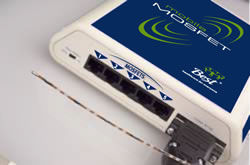
Dynamic Dose Measurements for Brachytherapy Dosimetry
The Linear 5ive MOSFET Array™, when used in combination with the mobileMOSFET™, is the first and only commercially available combination that allows for the real-time quality assurance of all brachytherapy procedures, without a significant investment in extra time.
Real-time dose profiling is provided by the in-vivo use of a mobileMOSFET Wireless Dosimetry System. The Linear Array is used for various HDR applications such as prostate and gynecological brachytherapy using model TN-252LA5.
When placed on the surface of the breast, the array can also validate MammoSite™ treatments. Implant and LDR dosimetry is performed using the higher sensitivity model TN-502LA5.
When inserted directly into a urethral catheter, the dose results provide immediate assessment of post-implant base and apex dose coverage, as well as the dose to organs at risk such as the urethra, rectum or bladder. This real-time dose feedback allows assessing the quality of the seed implant program in LDR and HDR brachytherapy. Absolute dose measurements or dose rate measurements are obtained in real-time. This will help validate the quality of treatment, and ultimately the quality of life for the patient.
MOSFET Calibration Jig
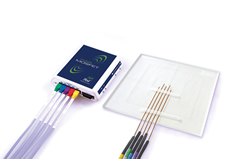
The MOSFET Calibration Jig (TN-RD-57-30) is designed for quick and easy MOSFET calibration with a simple set-up configuration. The jig reference lines can be easily aligned with the positioning lasers and linear accelerator light fields for 10 x 10 cm, 20 x 20 cm, and 30 x 30 cm fields. The use of the jig promotes easy and consistent positioning at the beam isocenter and, thereby, reproducible calibrations.
The MOSFET placement indentations not only aid positioning, but also prevent accidental damage to the MOSFETs with build-up material during calibration. The staggered positioning reduces the influence of scatter from adjacent MOSFETs and the symmetrical design allows comparison of opposing MOSFETs to each other, and quick verification of beam flatness and symmetry.
The relatively thin 1 cm thickness of the MOSFET Calibration Jig provides a moderate amount of backscatter, but is thin enough to permit customized irradiation set-up with additional backscatter and build-up materials.
Calibration with the mobileMOSFET Calibration Module Software
Calibration becomes even easier when the MOSFET Calibration Jig is combined with the mobileMOSFET Dose Verification System. The mobileMOSFET is completely software driven and contains a Calibration Module. The Calibration Module collects the calibration dose repetitions in a viewable pool of data. The software automatically calculates the Calibration Factor (CF), the average CF and the percent standard deviation for each MOSFET dosimeter. The CF data file can also be printed, saved, loaded, and edited.
Other Applications
In addition to calibration, the simplicity of the calibration jig lends itself to customized use in phantom-based measurements. The MOSFET arrangement can be used for dose measurement as a two-dimensional array that provides an inexpensive and quick validation of dose distribution. Due to the small active volume of the MOSFET (2 x 10-5mm3), there is limited dose averaging and therefore a better degree of accuracy in high field gradients. The standardized set-up geometry provides simple entry of positional data to treatment planning software, which can be compared to absolute MOSFET dosimeter measurements. The MOSFET dosimeters are also isotropic (± 2% for 360°) and have negligible energy dependence, which makes them an ideal dosimeter for IMRT validation.
Typically calibration measurements are done at Dmax, but the MOSFET Calibration Jig places the dosimeters on the surface of the jig to allow for customization of build-up. With no build-up applied, the Calibration Jig can be used for entrance CF estimation during surface dose measurements in radiotherapy or radiology applications.
Hemispherical Build-up Caps
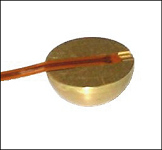
For use with MOSFET Dosimeters
MOSFETs are known to be highly accurate dosimeters that offer a wide range of measurement options, as one MOSFET can be used for all energies and modalities. MOSFET dosimeters have only 0.8mm inherent build-up, which allows for flexibility in measuring surface doses as well as doses at Dmax. In order to measure doses at Dmax, build-up is required. Measuring accurate doses at depth is of primary concern for the physics community when performing patient dosimetry. Precise dose measurement verifies that the target volume area has been treated with the appropriate dose, while sparing surrounding tissue and organs. Current tissue-equivalent build-up caps require a different size for each energy. Best Medical Canada offers a custom designed Build-up Cap for use with MOSFET Dosimeters, which allows for depth dose measurements over a wide range of energies.
Full Photon Range & 15MeV - 18MeV Electrons
Brass Build-up Caps – 0.635cm Radius (TN-RD-56-0.63)
In order to maintain the isotropic characteristics of the MOSFET dosimeter (±2% for 360°) and allow for one calibration factor for all energies and modalities, it is recommended that a hemispherical build-up cap be used. This small brass hemisphere is specially grooved for precise placement of the MOSFET and maintains the characteristics which distinguish these devices from other types of dosimeters.
The new brass build-up cap is very lightweight (only 4g) and small (radius: 0.635cm), which makes it ideal for placement on patients.
This build-up cap may be affixed to the MOSFET for the duration of its life (i.e. 200 doses). Using just one build-up cap for all Photons and some Electron energies makes the dosimeters easier for therapists to use and saves on patient set-up time, as only one dosimeter is required for all energies. Additionally, this method saves time spent on switching between different sizes of build-up for each treatment, e.g. IMRT with multiple energies.
Why Brass?
Brass is a metal alloy containing mainly copper and zinc compounds. Due to its high density (8.5g/cm3) and to its high Z number (Z ~ 30), it provides the minimal amount of metal needed to achieve full build-up at Dmax for a range of photon energies (4, 6, 10 and 18MV) and some electron energies (15 to 18MeV) at a very practical size.
The use of MOSFET Dosimeters under full build-up enables dose sampling at the charged particle equilibrium region, where the radiation response is maximum.
MOSFET Correction Factors (CR) Under Brass Build-up Caps
To directly correct for dose readings at Dmax, the system’s software allows for Correction Factor (CR) values to be entered which then convert MOSFET response to dose.
These CRs vary between 0.8 and 1.1 and are Linac and calibration setup dependent. They must be determined for any new MOSFET/Cap combination. These CRs may be stored in the system’s software dose measurement template.
For example, two sets of CRs were obtained with a Siemens Mevatron Linac at 6 and 18MV photon energies, with a nominal dose of 200 cGy at Dmax in water and 10 x 10 cm2 field size (100cm Source Axis Distance). Please refer to the following table for details:
Typical Correction Factors for Brass Build-up Caps (TN-RD-56-0.63)
| Energy | Correction Factor (CR) |
| 6 MV | 1.10 |
| 18 MV | 0.84 |
Note: The Correction Factor "CR" is the value used in the system software, along with the Calibration Factor "CF" to convert MOSFET response to dose. Please refer to Operators’ Manuals for further details.
Handling and Cleaning
Brass build-up caps are easily attached to the MOSFET. Circular adhesive patches are provided with the caps to fasten the MOSFET dosimeter to the build-up cap for the duration of the lifetime of the dosimeter. The cap/MOSFET is then adhered to the patient’s skin using paper tape.
Cleaning – use rubbing alcohol or alcohol swabs, which are usually found in any hospital/clinic environment.
Note: For low electron energies, It is suggested that no build-up is used. However, if desired, one can use the 1.5cm radius tissue equivalent build-up cap (model TN-RD-55-1.5).
